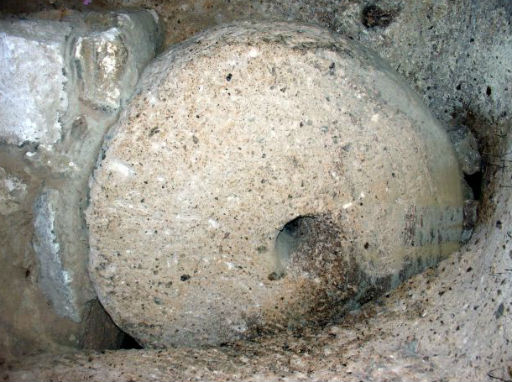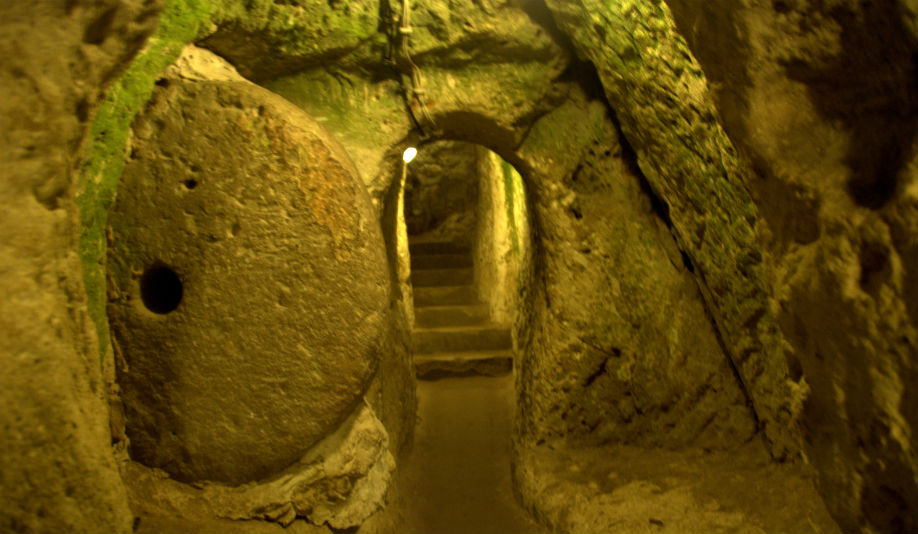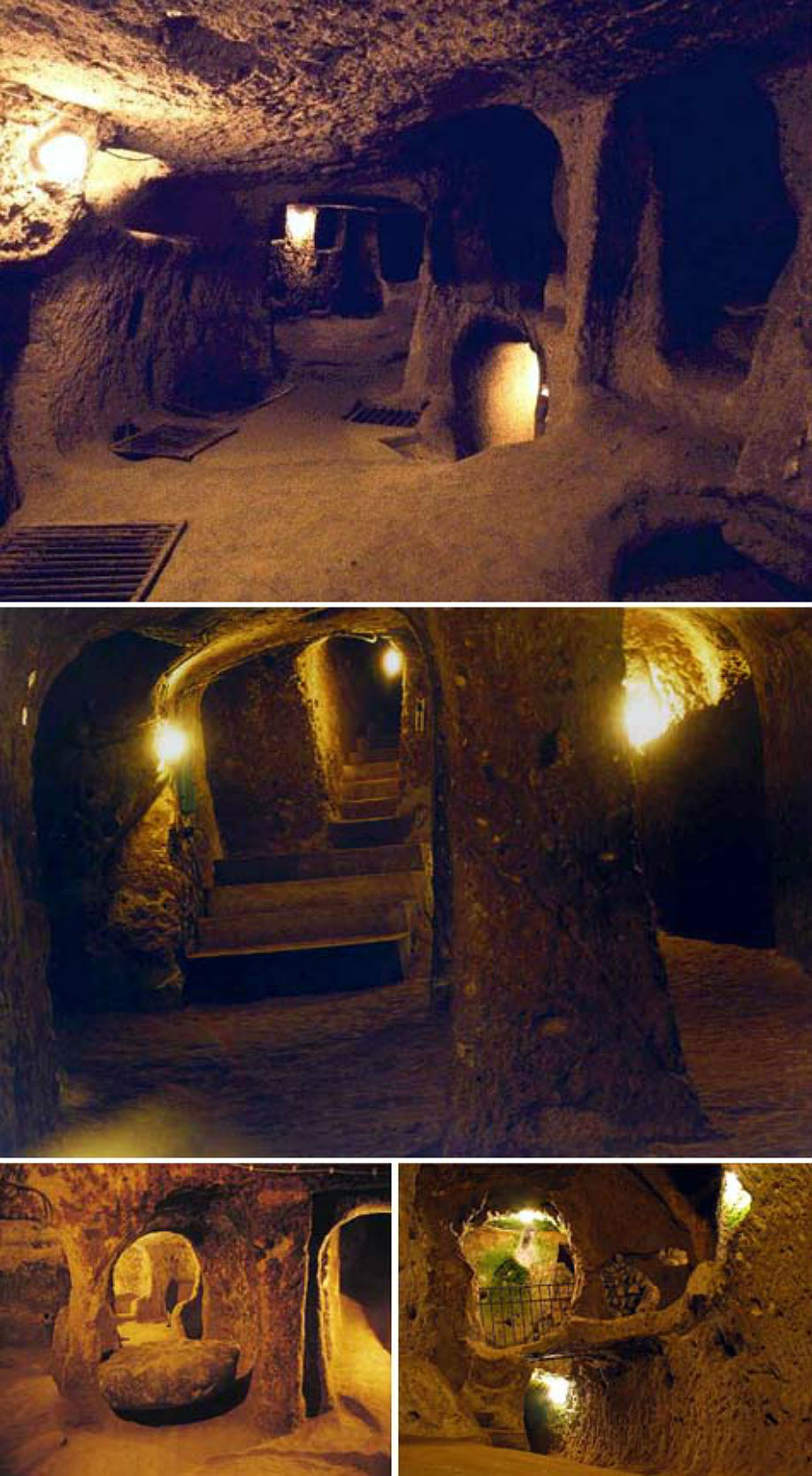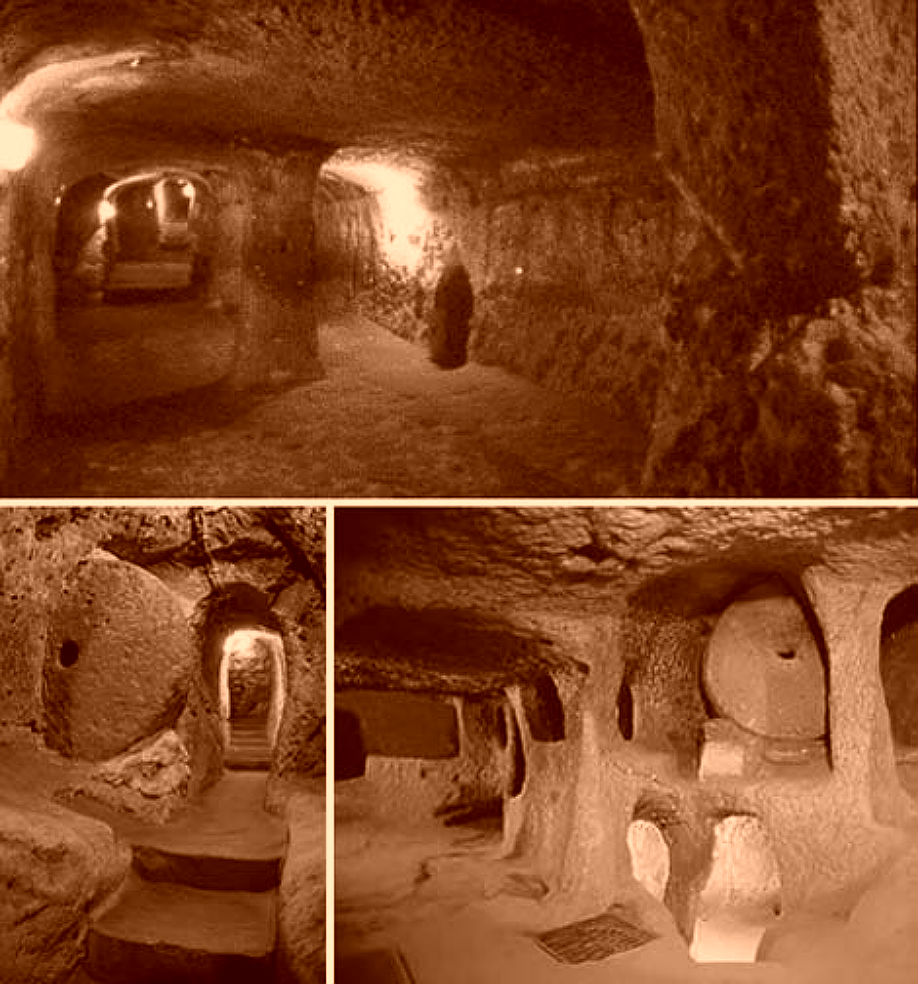Derinkuyu Underground City is an ancient multi-level underground city of the Median Empire in the Derinkuyu district in Nevşehir Province, Turkey.
Extending to a depth of approximately 60 m, it was large enough to shelter approximately 20,000 people together with their livestock and food stores.
It is the largest excavated underground city in Turkey and is one of several underground complexes found across Cappadocia.

One of the heavy stone doors. They have a height of 1–1,5 m, 30–50 cm in width and weigh 200–500 kg. The hole in the centre can be used to open or close the millstone, or to see who is outside.
It was opened to visitors in 1969 and to date, about half of the underground city is accessible to tourists. The underground city at Derinkuyu could be closed from the inside with large stone doors. Each floor could be closed off separately.
The city could accommodate up to 20,000 people and had all the usual amenities found in other underground complexes across Cappadocia, such as wine and oil presses, stables, cellars, storage rooms, refectories, and chapels. Unique to the Derinkuyu complex and located on the second floor is a spacious room with a barrel vaulted ceiling. It has been reported that this room was used as a religious school and the rooms to the left were studies.
Between the third and fourth levels is a vertical staircase. This passage way leads to a cruciform church on the lowest (fifth) level.
The large 55 m ventilation shaft appears to have been used as a well. The shaft also provided water to both the villagers above and, if the outside world was not accessible, to those in hiding.
History
First built in the soft volcanic rock of the Cappadocia region, possibly by the Phrygians in the 8th–7th centuries B.C according to the Turkish Department of Culture, the underground city at Derinkuyu may have been enlarged in the Byzantine era. During the Persian Achaemenid empire the city was used as a refugee settlement. There are references to underground refugee settlements built by the Persian king Yima in the second chapter of the Zoroastrian book Vendidad. Therefore many scholars believe that the city may have been built by the Persians. The city was connected with other underground cities through miles of tunnels.
Some artifacts discovered in these underground settlements belong to the Middle Byzantine Period, between the 5th and the 10th centuries A.D. It is speculated that the number of underground settlements, generally used for taking refuge and for religious purposes, increased during this era.
Derinkuyu Underground City, Cappadocia,





This is an amazing place to visit but I agree with the previous TA that you wouldn't do so well if you didn't like small spaces or not mobile. The ladies selling the handmade dolls on the outside of the city all scream out for you to buy their dolls – for 3 turkish lira each they're worth it.
I loved this museum because I am not a history but and I still enjoyed it. The museum is not filled with historical descriptions that you feel obligated to read. This is however a downside for people who do love history.
Talk about different- exploring this cave city feels like going through a Disneyland attraction. It's hard to believe people (and animals, including horses) lived here. Best part is the many giant round 'doors' used to block off enemies– it looks straight out of Indiana Jones. Suggest you go earlyish to avoid being stuck 6 floors down in the earth with…
I stayed in a renovated cave condo, looking across the valley to uninhabitated cave dwellings that had existed for centuries. It is the most phenomenal experience. Turkey is rich in history, layers of cultures. The underground cities are close by, another amazing archeological experience.
This is perhaps one of the key highlights of Turkey. There are lots of these cave dwellings located all over this region. In fact, many of them are not inhabited by anyone. As a backpacker, my friend and I had serious consideration of staying in one of these dwellings for a night or two just to experience how it must…
Just so amazing to see this natural feature and how it had been adapted. Well worth the walking and climbing to see these features. A real must if you have ventured to this area.
15tl for this entry.About 1hr is sufficient time. The first half there is no need to get a guide as you are only looking at what was once a city so it's mainly just hollowed out tunnels and rooms.Having said that, towards the end of visit you will go down some steep stairs.
15 TL to enter underground city and 20 TL for tour guide. It was well worth it to have a better understanding of who lived there, why, and how long. Apperently, out of the 32 underground cities this is one of four open to public.
The underground city itself is very interesting, the process of visiting it isn't. Lines of tourists, crowded conditions inside and no one to explain the what and why. This site cries out for an introductory video that shows how things were done and can be watched in different languages with earphones.
This was somewhat interesting, a entire city built underground however after seeing all the beauty in this region and staying in a cave hotel, visiting Derinkuyu Underground City did not feel as special. I would not recommend Derinkuyu Underground City to families with small children, the elderly, anyone with difficulty walking stairs or anyone with an upper respiratory illness/asthma.